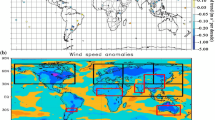Abstract
Atmospheric pressure is the weight of the air column that lies above the unit surface. This pressure is only partly influenced by the air velocity of the column. The value of air pressure changes both in space and in time. Pressure changes are greatest in the vertical direction, and close to sea level, they are about 1 mb every 10 m. In the horizontal direction, the typical pressure change is about 1–2 mb per 100 km. Despite the horizontal pressure changes are far less than vertical (at moderate latitudes about ten thousand times), they are of great importance for the dynamics of the atmosphere (e.g. Ackerman and Knox 2007; Markowski and Richardson 2010; Ćurić and Janc 2016; Houghton 2002; Lindzen 2005; Lutgens et al. 2018; Sanchez-Lavega 2011; Spiridonov and Ćurić 2011). Changes in atmospheric pressure in the horizontal direction and time can occur for both thermal and dynamic reasons. The cooling of the air causes the atmospheric pressure to rise, because the cooler air is denser and therefore heavier, while the value of the ground pressure decreases as the air warms, as it becomes less frequent and lighter. The air in the atmosphere is in constant motion. The penetration of cold or warm air causes changes in the atmospheric pressure in the observed area. In areas with upward air motion, the surface pressure decreases, while in areas downstream pressure increases. Atmospheric pressure is an indicator of weather. When a low-pressure system moves into an area, it usually leads to cloudiness, wind, and precipitation. High-pressure systems usually lead to fair, calm weather. If a barometre shows low barometric pressure tendency and shows air pressure tendency increase, it suggests that a high-pressure system is taking over and fair weather conditions are expected.
Access this chapter
Tax calculation will be finalised at checkout
Purchases are for personal use only
Similar content being viewed by others
References
Ackerman, S. A., & Knox, J. A. (2007). Meteorology: Understanding the atmosphere (2nd ed., 528 pp). Brooks/Cole.
Clift, P. D., & Plumb, R. A. (2008). The Asian monsoon – Causes, history and effects. Cambridge University Press. 270 str.
Ćurić, M. (2000). Selected chapters in dynamic meteorology (pp. 244 (11, 12)). Belgrade: University Press.
Ćurić, M., & Janc, D. (2016). Meteorology (p. 581). Belgrade-Zemun: AGM book d.o.o.
Etling, D. (2008). Theoretische Meteorologie – Eine Einführung (3. Auflage) (p. 376). Springer.
Galvin, J. P. F. (2015). An introduction to the meteorology and climate of the tropics (328 pp). Wiley-Blackwell.
Hantel, M. (2013). Einfuhrung theretische meteorologie (p. 430). Springer Spektrum.
Helmis, C. G., & Nastos, P. T. (Eds.). (2012). Advances in meteorology, climatology (1278 pp). Springer.
Hewitt, C. N., & Jackson, A. W. (2003). Handbook of atmospheric science (633 pp). Blackwell.
Houghton, J. T. (2002). Physics of atmospheres (pp. 320 (1, 2, 4)). Cambridge University Press.
Landberg, L. (2016). Meteorology for wind energy (p. 204). Wiley.
Lindzen, R. S. (2005). Dynamics in atmospheric physics (310 pp). Cambridge University Press.
Lutgens, F. K., Tarbuck, E. J., Herman, R., & Tasa, D. G. (2018). The atmosphere: An introduction to meteorology (14th ed., p. 528). Pearson.
Markowski, P., & Richardson, Y. (2010). Mesoscale meteorology in midlatitudes (pp. 407 (12, 13)). Wiley.
Sanchez-Lavega, A. (2011). An introduction to planetary atmospheres (588 pp). CRC Press (Taylor & Francis Group).
Spiridonov, V. (2010). Meteorology. ISBN 976-9989-57-642-331, COBBIS.MK-ID 79389450, pp. 317.
Spiridonov, V., & Ćurić, M. (2011). An introduction to meteorology (pp. 241 (1, 2, 3, 4, 6, 10, 11, 12, 16, 17, 18)). ISBN 978-608-65175-0-2 COBISS.MK-ID 83607306.
Author information
Authors and Affiliations
Rights and permissions
Copyright information
© 2021 Springer Nature Switzerland AG
About this chapter
Cite this chapter
Spiridonov, V., Ćurić, M. (2021). Atmospheric Pressure and Wind. In: Fundamentals of Meteorology. Springer, Cham. https://doi.org/10.1007/978-3-030-52655-9_8
Download citation
DOI: https://doi.org/10.1007/978-3-030-52655-9_8
Published:
Publisher Name: Springer, Cham
Print ISBN: 978-3-030-52654-2
Online ISBN: 978-3-030-52655-9
eBook Packages: Earth and Environmental ScienceEarth and Environmental Science (R0)



